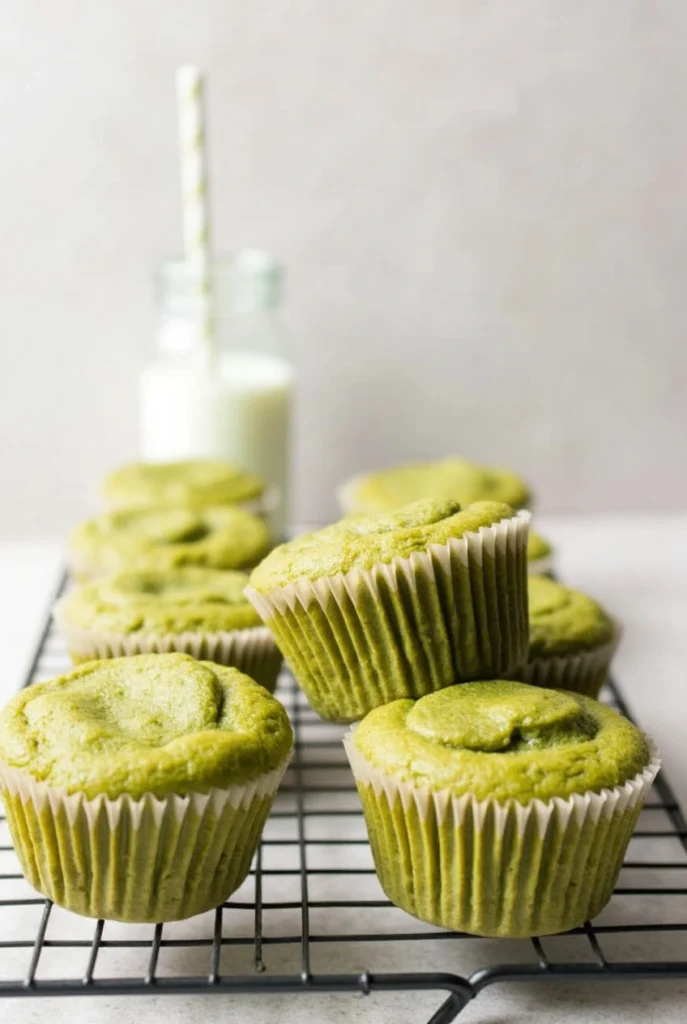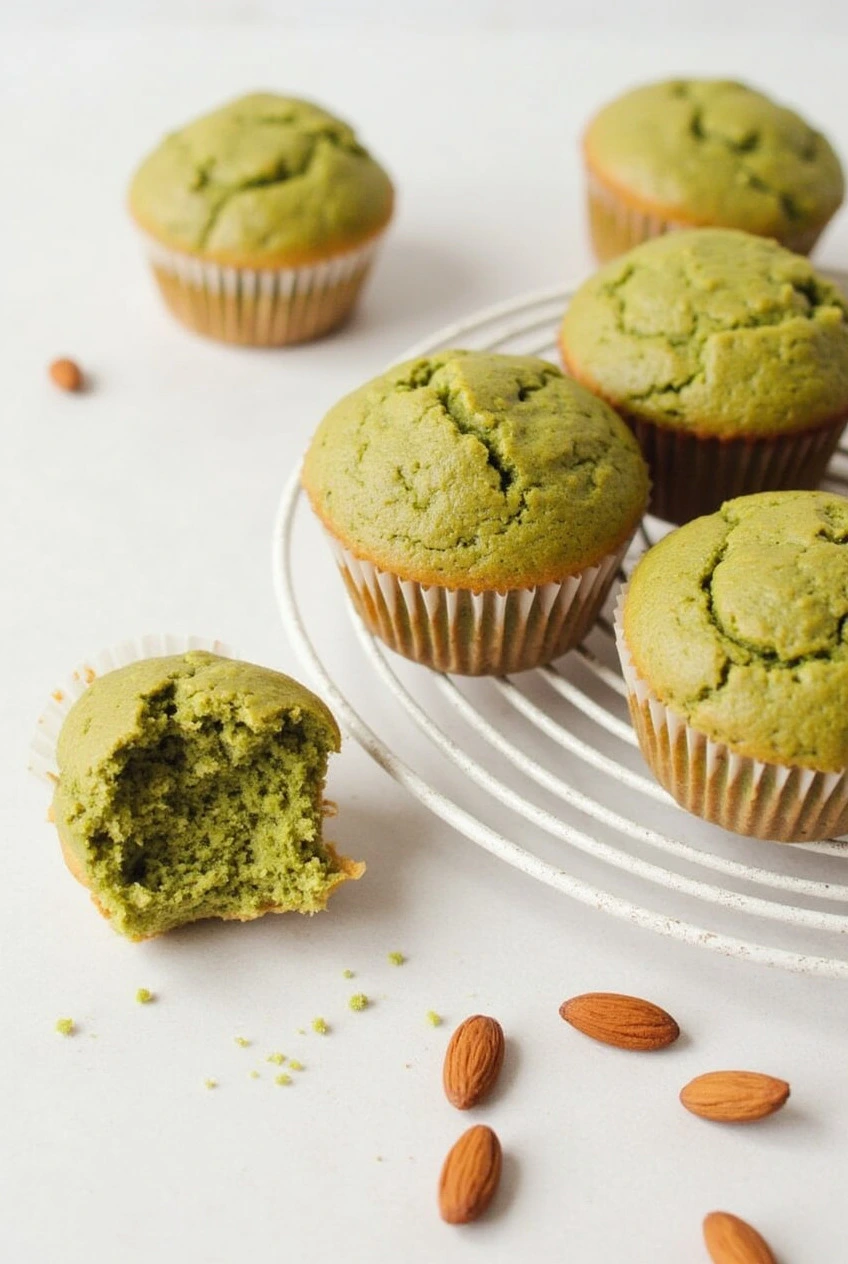Matcha Muffin Recipe with Almond Flour
Introduction
Imagine biting into a soft, moist muffin that’s not only delicious but also packed with health benefits. As someone who has struggled with gluten intolerance, I know the joy of finding a treat that satisfies both your taste buds and your dietary needs. That’s why I’m excited to share this gluten-free matcha muffin recipe with almond flour—a perfect blend of flavor and nutrition.
Table of Contents
Why Choose Gluten-Free Matcha Muffins with Almond Flour?
Health Benefits of Matcha
Matcha has gained immense popularity in recent years, and for good reason. This vibrant green powder is more than just a trendy ingredient; it’s a powerhouse of health benefits. Here are some reasons why you should incorporate matcha into your diet:
- Rich in Antioxidants: Matcha is known for its high concentration of antioxidants, which help protect your cells from damage. These antioxidants, particularly catechins, are more potent than those found in regular green tea.
- Boosts Metabolism: The catechins in matcha can enhance your metabolism, aiding in weight management. By increasing your body’s ability to burn calories, matcha can be a valuable addition to your weight loss journey.
- Enhances Focus: Matcha contains L-theanine, an amino acid that promotes relaxation and focus without the jittery side effects of caffeine. This unique combination of caffeine and L-theanine makes matcha an excellent choice for improving mental clarity and concentration.
Nutritional Value of Almond Flour
Almond flour is a versatile and nutritious alternative to traditional wheat flour. Here’s why you should consider using almond flour in your baking:
- High in Protein: Almond flour is a great source of plant-based protein, essential for muscle repair and growth. This makes it an excellent choice for those looking to increase their protein intake.
- Low in Carbohydrates: Perfect for those following a low-carb or ketogenic diet, almond flour has a lower carbohydrate content compared to wheat flour. This makes it a suitable option for managing blood sugar levels and supporting weight loss.
- Rich in Healthy Fats: Almond flour provides monounsaturated fats, which are beneficial for heart health. These healthy fats can help reduce inflammation and improve cholesterol levels.
Ingredients for Gluten-Free Matcha Muffins
Dry Ingredients
| Ingredient | Quantity |
|---|---|
| Almond Flour | 2 cups |
| Matcha Powder | 2 tbsp |
| Baking Powder | 1 tsp |
| Salt | 1/4 tsp |
Wet Ingredients
| Ingredient | Quantity |
|---|---|
| Eggs | 3 |
| Honey | 1/3 cup |
| Coconut Oil | 1/4 cup |
| Vanilla Extract | 1 tsp |
Step-by-Step Matcha Muffin Recipe
Preparation
- Preheat the Oven: Set your oven to 350°F (175°C) and line a muffin tin with cupcake liners.
- Combine Dry Ingredients: In a large bowl, mix together the almond flour, matcha powder, baking powder, and salt.
- Mix Wet Ingredients: In another bowl, whisk the eggs, honey, coconut oil, and vanilla extract until well combined.
- Combine Both Mixtures: Gradually add the dry ingredients to the wet ingredients, stirring until just combined.
- Fill Muffin Tin: Evenly distribute the batter into the prepared muffin tin.
- Bake: Place the muffin tin in the preheated oven and bake for 20-25 minutes, or until a toothpick inserted into the center comes out clean.
- Cool: Allow the muffins to cool in the tin for 5 minutes, then transfer them to a wire rack to cool completely.
Tips for Perfect Matcha Muffins
- Measure Accurately: Baking is a science, so precise measurements are crucial.
- Use Fresh Ingredients: Ensure your matcha powder and almond flour are fresh for the best flavor.
- Avoid Overmixing: Overmixing the batter can result in dense muffins. Mix until just combined.
The Magic of Matcha: A Deep Dive
Matcha is more than just a trendy ingredient; it’s a superfood with a rich history and numerous health benefits. Originating from Japan, matcha is a type of green tea made from young tea leaves that are stone-ground into a fine powder. Unlike traditional green tea, where the leaves are steeped in water and then discarded, matcha powder is whisked directly into hot water, allowing you to consume the entire leaf and all its nutrients.
Historical Significance
Matcha has been a staple in Japanese culture for centuries, with its origins tracing back to the 12th century. It was initially used by Buddhist monks to aid in meditation, thanks to its unique combination of caffeine and L-theanine, which promotes alertness and calmness. Over time, matcha became an integral part of the Japanese tea ceremony, a ritual that embodies harmony, respect, purity, and tranquility.
Modern-Day Benefits
In recent years, matcha has gained global recognition for its numerous health benefits. Here are some of the key advantages of incorporating matcha into your diet:
- High in Antioxidants: Matcha is rich in antioxidants, particularly catechins like epigallocatechin gallate (EGCG). These antioxidants help protect your cells from damage and reduce the risk of chronic diseases.
- Boosts Metabolism: The catechins in matcha can enhance your metabolism, aiding in weight management. By increasing your body’s ability to burn calories, matcha can be a valuable addition to your weight loss journey.
- Enhances Focus: Matcha contains L-theanine, an amino acid that promotes relaxation and focus without the jittery side effects of caffeine. This unique combination of caffeine and L-theanine makes matcha an excellent choice for improving mental clarity and concentration.
- Supports Heart Health: The antioxidants and polyphenols in matcha can help lower cholesterol levels and reduce the risk of heart disease.
- Detoxifies the Body: Matcha is rich in chlorophyll, a natural detoxifier that helps eliminate toxins and heavy metals from the body.
The Versatility of Almond Flour
Almond flour is a versatile and nutritious alternative to traditional wheat flour. Made from finely ground almonds, this gluten-free flour is a staple in many healthy baking recipes. Here’s why you should consider using almond flour in your baking:
Nutritional Benefits
- High in Protein: Almond flour is a great source of plant-based protein, essential for muscle repair and growth. This makes it an excellent choice for those looking to increase their protein intake.
- Low in Carbohydrates: Perfect for those following a low-carb or ketogenic diet, almond flour has a lower carbohydrate content compared to wheat flour. This makes it a suitable option for managing blood sugar levels and supporting weight loss.
- Rich in Healthy Fats: Almond flour provides monounsaturated fats, which are beneficial for heart health. These healthy fats can help reduce inflammation and improve cholesterol levels.
- High in Vitamins and Minerals: Almond flour is rich in vitamins and minerals, including vitamin E, magnesium, and manganese. These nutrients support various bodily functions, such as immune function, bone health, and energy production.

Baking with Almond Flour
Baking with almond flour can be a bit different from using traditional wheat flour. Here are some tips to help you achieve the best results:
- Measure Accurately: Almond flour can be denser than wheat flour, so it’s important to measure accurately. Using a kitchen scale can help ensure precise measurements.
- Use Eggs: Eggs act as a binding agent in almond flour recipes, helping to hold the ingredients together. If you’re following a vegan diet, you can use flax eggs or chia eggs as a substitute.
- Add Leavening Agents: Since almond flour is denser than wheat flour, it’s important to use leavening agents like baking powder or baking soda to help your baked goods rise.
- Adjust Liquids: Almond flour absorbs more liquid than wheat flour, so you may need to adjust the amount of liquid in your recipe. Start with a smaller amount of liquid and add more as needed.
- Bake at a Lower Temperature: Almond flour can brown more quickly than wheat flour, so it’s best to bake at a lower temperature to prevent burning.
Creative Variations of Matcha Muffins
While the classic matcha muffin recipe is delicious on its own, there are plenty of ways to customize and enhance the flavor. Here are some creative variations to try:
Chocolate Chip Matcha Muffins
Adding chocolate chips to your matcha muffins can create a delightful balance of flavors. The bittersweet chocolate complements the earthy matcha, resulting in a treat that’s both indulgent and healthy. Simply fold in 1/2 cup of dark chocolate chips into the batter before baking.
Blueberry Matcha Muffins
For a fruity twist, try adding blueberries to your matcha muffins. The tartness of the blueberries pairs well with the slight bitterness of the matcha, creating a harmonious blend of flavors. Gently fold in 1 cup of fresh or frozen blueberries into the batter before baking.
Lemon Matcha Muffins
The bright, citrusy notes of lemon can enhance the flavor of matcha, making for a refreshing and zesty treat. Add the zest of one lemon and 1 tablespoon of lemon juice to the wet ingredients before combining with the dry ingredients.
Coconut Matcha Muffins
Incorporating coconut into your matcha muffins can add a tropical twist and enhance the moistness of the muffins. Replace the coconut oil with melted coconut butter and fold in 1/2 cup of shredded coconut into the batter before baking. You can also sprinkle some shredded coconut on top of the muffins before baking for added texture.
Cranberry Orange Matcha Muffins
The combination of cranberries and orange can create a festive and flavorful matcha muffin. Add the zest of one orange and 1 tablespoon of orange juice to the wet ingredients. Fold in 1/2 cup of dried cranberries into the batter before baking.
Matcha Muffins for Special Diets
Matcha muffins can be easily adapted to suit various dietary needs and preferences. Here are some tips for making matcha muffins that cater to special diets:
Vegan Matcha Muffins
To make vegan matcha muffins, you can substitute the eggs with flax eggs or chia eggs. For each egg, mix 1 tablespoon of flaxseed meal or chia seeds with 2.5 tablespoons of water and let it sit for a few minutes to thicken. You can also replace the honey with maple syrup or agave nectar.
Paleo Matcha Muffins
For a paleo-friendly version, ensure that all ingredients are compliant with the paleo diet. Almond flour and coconut oil are already paleo-friendly, but you may need to substitute the baking powder with a paleo-approved version. You can also replace the honey with maple syrup or coconut nectar.
Keto Matcha Muffins
To make keto matcha muffins, you can replace the honey with a low-carb sweetener like erythritol or allulose. Ensure that all other ingredients are low in carbohydrates to keep the muffins keto-friendly.
Nut-Free Matcha Muffins
If you have a nut allergy or prefer a nut-free option, you can substitute the almond flour with a different gluten-free flour like coconut flour or a gluten-free all-purpose blend. Keep in mind that the texture and taste may vary, and you may need to adjust the liquid content accordingly.
Storing and Freezing Matcha Muffins
Properly storing your matcha muffins can help maintain their freshness and flavor. Here are some tips for storing and freezing matcha muffins:
Room Temperature Storage
Store the muffins in an airtight container at room temperature for up to 3 days. Ensure the container is sealed tightly to prevent the muffins from drying out or absorbing odors from the environment.
Refrigerator Storage
For extended freshness, store the muffins in an airtight container in the refrigerator for up to a week. Allow the muffins to cool completely before storing them to prevent condensation, which can make the muffins soggy.
Freezer Storage
Matcha muffins can be frozen for up to 3 months. To freeze, place the cooled muffins in an airtight container or freezer bag, separating layers with parchment paper to prevent them from sticking together. When ready to enjoy, thaw the muffins at room temperature or reheat them in the oven or microwave.

Frequently Asked Questions (FAQ)
Can I use a different type of flour?
While almond flour is recommended for its nutritional benefits and gluten-free properties, you can experiment with other gluten-free flours like coconut flour or a gluten-free all-purpose blend. However, the texture and taste may vary.
How should I store these matcha muffins?
Store the muffins in an airtight container at room temperature for up to 3 days, or in the refrigerator for up to a week. You can also freeze them for up to 3 months.
Can I make this matcha muffin recipe vegan?
Yes, you can substitute the eggs with flax eggs (1 tablespoon of flaxseed meal mixed with 2.5 tablespoons of water per egg) and use maple syrup instead of honey to make the recipe vegan.
Can I use regular green tea instead of matcha?
Matcha powder is essential for achieving the vibrant green color and unique flavor of these muffins. Regular green tea will not provide the same results, as it is not as concentrated or finely ground as matcha.
Can I add other mix-ins to the muffins?
Absolutely! Feel free to add other mix-ins like nuts, seeds, or dried fruits to customize the flavor and texture of your matcha muffins. Just be mindful of the overall moisture content and adjust the liquid ingredients accordingly.
Conclusion
Indulging in a gluten-free matcha muffin made with almond flour is more than just a treat—it’s a nourishing experience. With its rich flavor and numerous health benefits, this recipe is sure to become a staple in your kitchen. So, go ahead and bake a batch—your taste buds and your body will thank you!
Have you given our recipe a try ?
There are no reviews yet. Be the first one to write one.

